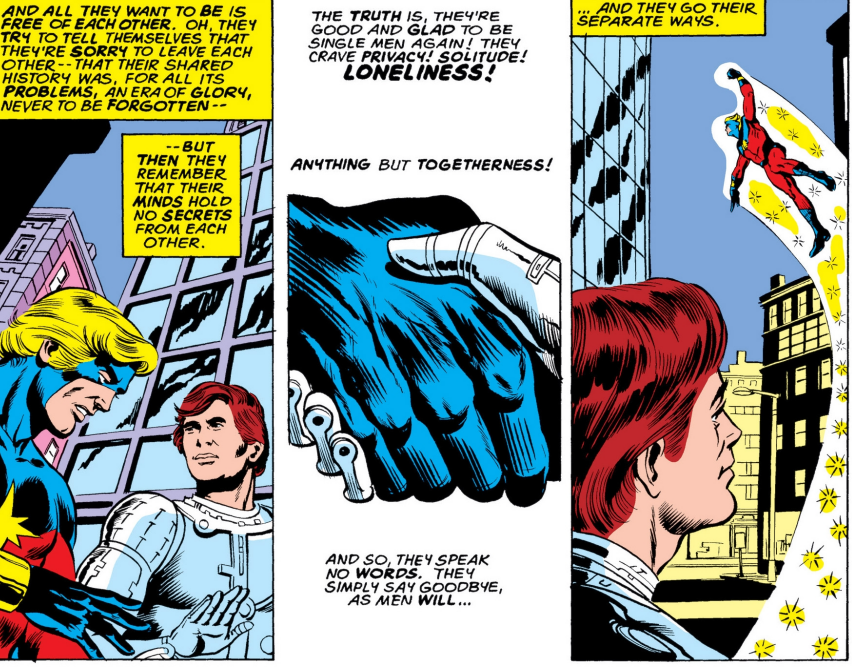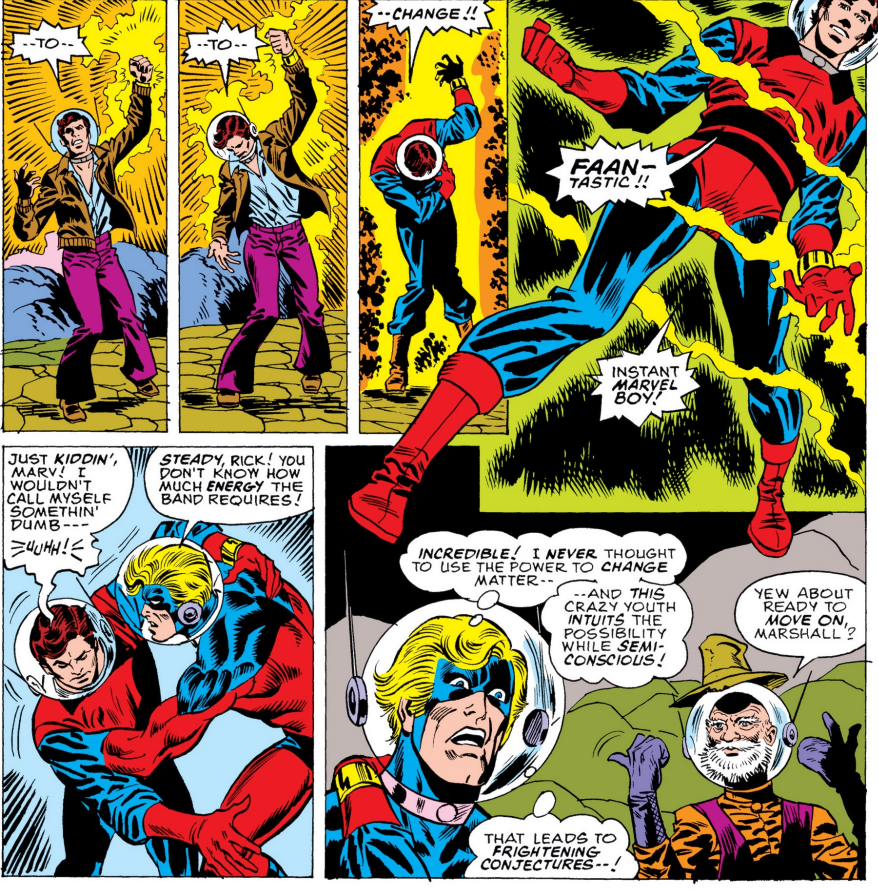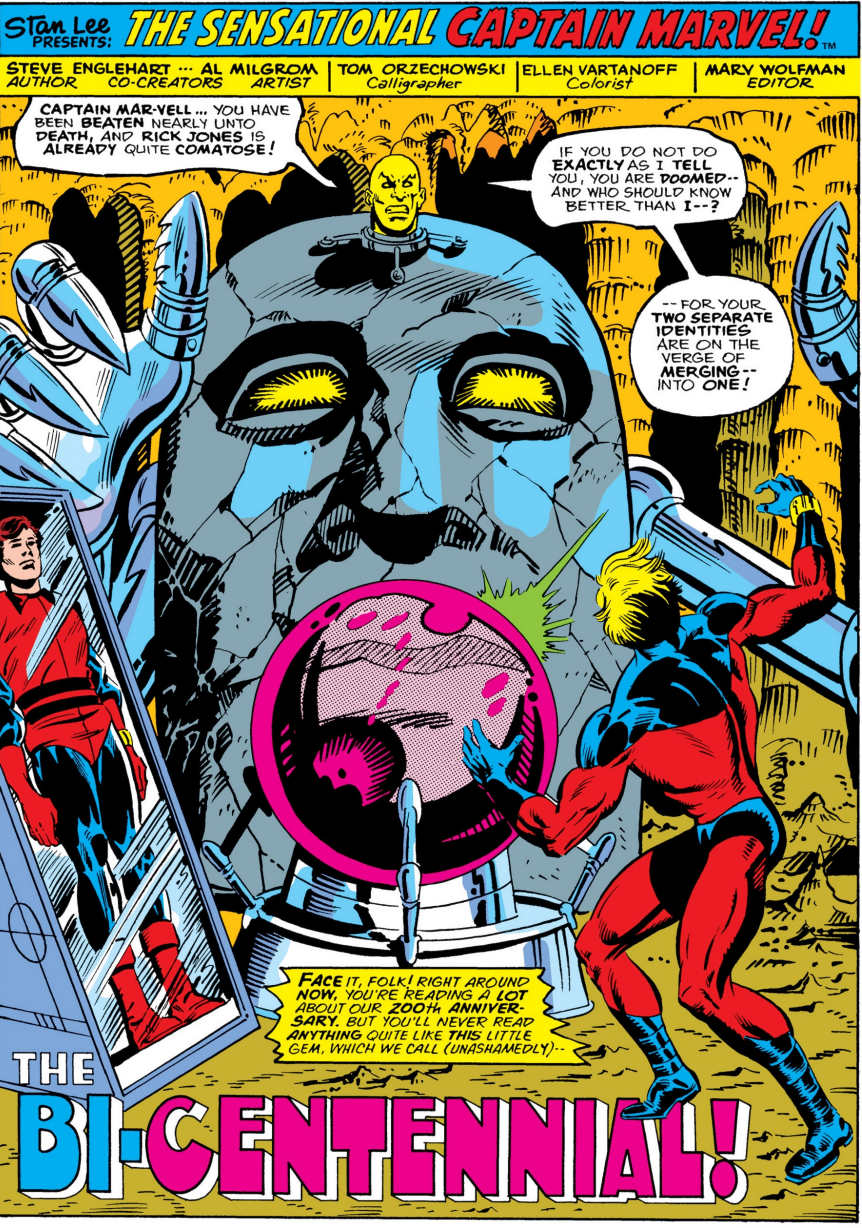Being Rick Jones
The remainder of Englehart’s run on Captain Marvel works within a new status quo: Rick and Mar-Vell can co-exist in the positive cosmos, but also can merge at will when it is more convenient for Captain Marvell to function alone (when flying in space, for instance). The Kree Supreme Intelligence, who reveals himself to be Mar-Vell’s stealthy arch-nemesis, complicates things further in Issue 41 when he divides the Nega-Bands between Mar-Vell and Rick, thereby also giving Rick access to some of Mar-Vell’s power.
From an editorial standpoint, it was a foregone conclusion that Rick and Mar-Vell would stick together after their release from the Negative Zone, but motivating their continued collaboration within the logic of the story took some effort. After the trial of the Watcher, Issue 40 shows the two men back on earth, each reveling in their newfound independence:
"And all they want to be is free of each other. Oh, they try to tell themselves that they’re sorry to leave each other—that their shared history was, for all its problems, an era of glory, never to be forgotten—
“—but then they remember that their minds hold no secrets from each other.
“The truth is, they’re glad to be single men again! They crave privacy! Solitude! LONELINESS!
“Anything but togetherness!
“And so, they speak no words. They simply say goodbye, as men will…
“…and they go their separate ways.”
By the end of that same issue, they are standing together against the backdrop of a sunset, each with their hand on the other’s shoulder, and Mar-Vell with his hand on Ricks’ wrist. Mar-Vell has just resolved to leave Earth, to which Rick responds:
“Amen, brother.”
“My destiny’s not here either, man. I’m just as out of place as you.
“Take me with you, Marv!”
What leads them to this decision is a parallel set of emotional traumas and failed attachments. Rick has arrived just in time for his gig, but is functionally a man displaced from time. He no longer recognizes young people’ fashions, and is still wearing the space suit he used for his trip across the galaxy. His performance on stage is greeted with laughter:
"The 50s haircut—the 60s ballads—the 70s spacesuit—!"
“He’s the renaissance man of decadence!
“Instant time warp!”
Infuriated, Rick harnesses the power of his spacesuit’s exoskeleton to tear up the stage before storming off.
Meanwhile, Mar-Vell’s lost love, Una, killed years ago by his enemy Yon-Rogg and reanimated by Eon as a mindless, aggressive zombie in Issue 29 (he had his reasons), has been possessed by a roving space parasite. Returning to Earth, she seeks out her lost love, first attacking a not-yet-superpowered Carol Danvers, who had been set up as a possible rival for Mar-Vell’s affections in the early issues of the series. Mar-Vell has no choice but to kill her again, which is when he decides to leave Earth.
With decades of slash fiction and queer theory separating us from these stories, it is tempting to see the Rick/Mar-Vell relationship in terms of unacknowledged homoeroticism. And far be it from me to try to “rescue” a fictional male friendship from queer subtext. But what is going on in these stories is actually more interesting than that. One of the reasons that final panel of issue 40 is so memorable is that the novelty of seeing Rick and Mar-Vell in physical contact is a function of their unusual bond: until now, their connection has been a matter of minds, more metaphysical than physical. There is love here, to be sure, but it is based on hyperconnection and identification rather than eros. Their relationship is to actual homoeroticism what René Girard’s homophobic theories are to real, lived homosexuality; Girard explains away homosexual feeling as the desire to resemble the object of desire, while Rick needs to be Mar-Vell.
Within their storyworld, Rick and Mar-Vell complement each other in a fashion that mimics the editorial rationale behind putting them together in the first place. On their own, neither of them showed much promise as full-fledged characters. Captain Marvel was terminally bland, while Rick, the eternal sidekick, only made sense when paired with a superpowered hero. The star of Englehart’s Captain Marvel was neither Rick nor Mar-Vell, but Rick-and-Mar-Vell. This does not mean that there was no conflict between the two; quite the contrary, that conflict was the heart of the story. The intermingling of their minds that began with the “Vitamin C” incident rendered the distinction between internal and interpersonal conflict almost meaningless.
Englehart’s last Captain Marvel storyline (Issues 41-46) turns all the subtext of the Rick/Mar-Vell relationship into text. The Supreme Intelligence reveals why he has been manipulating Mar-Vell for all the hero’s adult life. The Captain had become the greatest of Kree warriors, but this was despite his own personal flaws:
“You had one fatal weakness: an utter lack of personal ambition! YOu were a product of my space corps, content to climb the ladder of rank like any other officer—
“—and that could not be!”
“I was obliged to prod you!”
From the 1980s on, major comic book crossover events tended to feature adversaries who were stand-ins for editors: The Anti-Monitor in Crisis on Infinite Earths destroyed alternate universe because the powers-that-be wanted a single universe; Parallax messed with time in Zero Hour because the editors want to fix DC’s timeline, and the Beyonder in Secret Wars set all of Marvel’s heroes against all of Marvel’s heroes because that was the primary mandate of the series. Now the Supreme Intelligence lays bare Englehart’s narrative agenda, explaining the need to combine the unambitious Mar-Vell with the unpredictable and imaginative Rick Jones.
The Supreme Intelligence needs the Mar-Vell/Rick Jones connection in order to make it possible for him to assimilate the very in-Kree mind of the young Earthman. During the Kree-Skrull War, the Intelligence had explained that the Kree had reached an “evoutionary dead end” [1], while Jones himself turned out to be the key to ending the war. Jones, like all Earthpeople, has the potential for greatness inherent in a species that is so prone to mutation, accident, and a myriad of other means for developing superpowers. [2]. Prodded by the Supreme Intelligence, Rick used his latent mental powers to summon simulacra of the superheroes whose comics he (and writer Roy Thomas) had read in his youth.
If the Supreme Intelligence is a stand-in for the writer, Rick is a surrogate for the avid comics reader, whose well-trained imagination is ready for any heroic battle. Now armed with a Nega-Band, he is far more creative with the power than Mar-Vell ever was. After learning to fly within minutes of gaining the band, in Issue 42 he realizes that he can use the power to transform his clothes into costume more suited for outer space. Madr-Vell is stunned:
“incredible! I never thought to use the power to change matter—
“—and this crazy youth intuits the possibility while semi-conscious!
“That leads to frightening conjectures—!”
Perhaps it does, but one that appears to escape Mar-Vell is Rick’s choice of costume: it is the same color scheme as Captain Marvel’s, only reversed: with the exception of the solid-red tunic and the lack of a mask, every other element is blue where Mar-Vell’s is red and red where Mar-Vell’s is blue. Rick is simulnateoulsy imitating Mar-Vell, complementing him, and setting himself up as the Captain’s opposite number. Issue 42 takes place on a planet where everything resembles the Old West, and the default narrative pushes them into particular roles: the star on the Captain’s chest leads one of the inhabitants to assume Mar-Vell is a marshall (“You called me Mar-Shall. That is not my name…”) Soon Rick is joking referring to himself as his partner’s deputy, but he will not be satisfied with a subordinate position for long.
Immediately after wondering to himself what else he can do with is new power (“I don’t have to play second fiddle any more”), Rick spies a beautiful woman in a saloon. That woman, whose name is Fawn, will follow him to other planets over the next few issues, until it is revealed that Rick had created her with his mind. Mar-Vell never used the Nega-Bands to create an imaginary friend, but Rick does so without giving it any conscious thought. Though they share Captain Marvel’s power, and though Mar-Vell is undoubtedly a more formidable warrior, Rick brings with him the power that stopped the Kree-Skrull War: his imagination. And it is one power that Mar-Vell sorely lacks.
Over the next two issues, while Rick is learning more about Fawn, Mar-Vell is forced to battle a former ally, Drax the Destroyer. Drax had been created by the god Chronos (and the writer/artist Jim Starlin) as the ultimate adversary for Thanos, and now that Thanos is (presumed) dead, Drax has been wandering the galaxy without purpose. He blames Mar-Vell for killing Thanos and depriving Drax’s existence of any meaning.
The fight is complicated by Mar-Vell’s reluctance to do battle, and by the fact that he and Rick are inadvertently siphoning power from each other, along with personality traits (giving in to his fury, Mar-Vell starts using Rick’s slang). Though Drax is not evil, he is the perfect opponent for Mar-Vell: single-minded, uniimaginative, and forced to play out the same behavioral loops again and again. Mar-Vell only starts to win when he inadvertently steals so much energy from Rick that the young man nearly dies, and when he also starts to talk and act like Rick. Drax is an extreme version of what Mar-Vell could have been without Rick: a consummate warrior who is unable to think outside the framework within which he finds himself.
Fortunately, Mar-Vell is in no danger of becoming so limited, because he has Rick. Rick, however, is both solution and problem rolled into one. Even though they can co-exist in the positive cosmos, their interdepedence has only increased. The Supreme Intelligence declares his goal of merging the two men in order to assimilate Rick, and merger is a very real threat. The storyline is built on three concentric circles of conflict and merger: the Supreme Intelligence’s agenda, Rick’s and Mar-Vell’s problem, and the battle between the indigenous population of Deneb IV and the genocidal Nult-Trons encountered by the heroes in Issues 44 and 45.
After narrowly escaping the Null-Trons, Captain Marvel is subdued by a band of Denebians, who bring him and Rick to their General: a humanoid head grafted to the body of a Null-Tron (itself a giant, stony head with mechanical arms). The General is only the most extreme case of the problem that has best his race: over the course of the war, most of the Debians have lost limbs and become cyborgs, while the General has lost his entire body.
Somehow, the General know all about Mar-Vell’s and Rick’s problem: as he explains:
“If you do not do exactly as I tell you, you are doomed—and who should know better than I—?
“—for your two separate identities are on the verge of merging—into one!”
Conveniently, the General has a giant soul gem that can absorb the two men into itself and serve as their final battleground. His is not helping out of the goodness of his no-longer-existent heart; as Mar-Vell and Rick battle within the phantasmagorical realm inside the gem, everything they do is reflected by the two warring armies on the surface of Deneb. The General, part humanoid, part Null-Tron, cannot decide where his loyalties lie, so he has set up a proxy war in order to determine which side will 2in.
Their fight ends abruptly, much as the entire storyline would (with Englehart on his way out of Mavel and the last issue assigned to newcomer Chris Claremont for scripting). Fawn, Rick Jone’s dream girl unconsciously created by his psychic powers, enters the should gem and “opens” their mind to the truth:
“Your obsessions with winning, one over the other, are irrational!
“Granted, that only makes them stronger—
“Especially here, at the cores of your beings—
“but believe me, should either of you win, he’d be much the poorer for it!
“Yes, you’ve changed from before you were linked, and you’ll continue to change—
“but change is life, and life is always preferable to death!
“You won’t merge—not if you don’t want to! Make use of your unique abilities! Don’t let them make use of you!”
It’s not the most satisfying resolution for a conflict, relying as it does on a Fawn-ex-machina. Her powers of persuasion immediately put an end to the fighting, so they can confront (and defeat) the Supreme Intelligence in Issue 46. Fawn conveniently dies, in a moment that at least has the virtue of symmetry: Mar-Vell resolves to leave Earth in Issue 40 when forced to kill the parasite-tontrolled body of his former love Una, and now Rick has to watch Fawn die before he and Mar-Vell resolves to return to Earth once more.
Notes
[1] Yes,this is terrible science, but the misinterpretation of evolution as teleological is a common trope in superhero comics and televised science fiction.
[2] Thousands of years ago, the Kree experimented on primitive humans to create the super-powered Inhumans discussed in Chapter 1.






